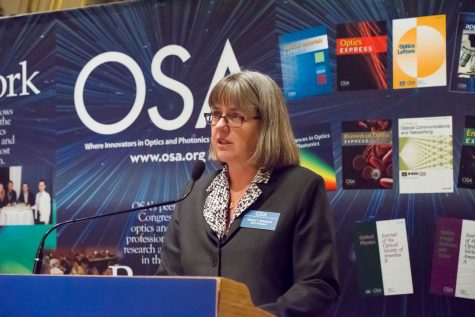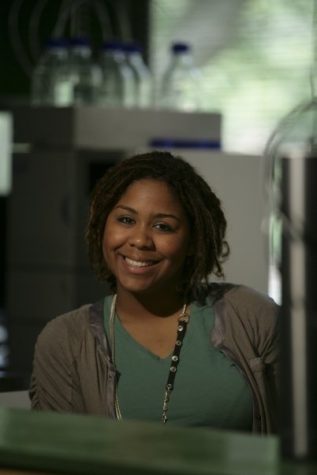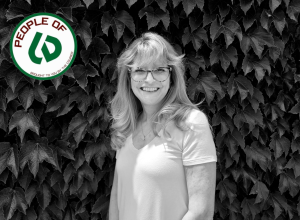Challenging gender inequality in the world of physics
COD Professor of Physics Alexandra Bennett worked at Fermilab, and Europe’s CERN’s Compact Muon Solenoid, one of the detectors along the Large Hadron Collider
October 11, 2018
“Physics was invented and built by men.”
CERN physicist Alessandro Strumia shocked an audience of young female scientists attending a Sept. 28 lecture meant to highlight gender and diversity challenges in the world of physics.
“Physics is not sexist against women…It is part of a political battle coming from the outside,” he said. Presenting graphs showing male disadvantages in hiring, he argued the field was becoming sexist against the superior merits of men.
CERN’s Large Hadron Collider shatters protons traveling at 99.99% the speed of light into thousands of subatomic particles. However, shattering the glass ceiling prohibiting equality for women has proven a more difficult challenge.
College of DuPage Professor of Physics Alexandra Bennett knows the intimidation women must overcome to succeed against the entrenched gender bias. She believes such comments perpetuate the stereotype women are inferior at science than men.
“When I asked professors where I should apply for grad school, they told me look at (each) program. I was cautioned, if they didn’t have any female faculty, there might be a reason why,” she said.
Bennett previously worked at Fermilab and also Europe’s CERN’s Compact Muon Solenoid, one of the detectors along the Large Hadron Collider. Her thesis analyzed the likelihood of dark matter interactions inside the collider. She believes the field is more welcoming than a generation ago. However, she warned of the acknowledged explicit bias dissipating into an unconscious bias.
Pointing to signs of progress, she referenced the 2018 Nobel Prize in Physics being co-awarded to Canadian Donna Strickland, the first female winner in 55 years. Strickland is only the third woman ever awarded. She was celebrated for her contribution to the shortest and most intense laser pulses ever created. Her technique, called Chirped Pulse Amplification uses her ultra-sharp laser beams to make precise incisions in cancerous tumors and perform corrective eye surgeries.

“We need to celebrate women physicists because they’re out there…I’m honored to be one of those women,” Strickland stated.
Fermilab physicist Jessica Esquivel was dismayed by the comments from since-suspended Strumia. She is a postdoctoral research associate working on the Muon g-2 experiment using magnetic fields to study the short-lived muon particles popping in and out of existence. She previously worked on Fermilab’s MicroBooNe neutrino experiment.
Esquivel’s identity as a Mexican, black lesbian in physics inspired her to work as part of the U.S. Delegation for the International Conference for Women in Physics. She pointed to implicit bias, microaggressions, stereotype threat and a lack of role models being barriers women face hindering their careers.
“I faced gender discrimination in undergrad but because of my advisor, Dr. Cardenas, and the Hispanic culture (surrounding) me, I felt safe and confident to push back.
“We as a physics community not only need to focus our efforts on recruitment but also retention, which may require an overhaul of the system in place. Not using equity, diversity and inclusion as a selling point, but actively evaluating and re-evaluating the culture at a specific lab or university,” she said.
Esquivel works on Fermilab’s offices of diversity, communication and education to increase visibility of women and underrepresented minorities in physics. She often meets with high school and college groups to spread awareness and motivate students.
According to the National Science Foundation, only 20% of U.S. physics undergrads and grad students are women. The same number is found in female assistant professors.
Bennett explained the intimidation felt in always being in the minority of her undergraduate and graduate courses.
“It had a deep effect when I’d look around a classroom and didn’t see many students like me,” she said. “I never had a female professor as a lecturer in my classes as an undergrad. I had to look hard to find role models to show me a trajectory my career could take.”
She pointed to the forming of support groups between female students in providing her a community of reassurance and encouragement. She also credited the inspiration provided by a female professor who ran the first lab Bennett worked on. She felt she couldn’t turn to male professors with maternal questions about childcare, and her lab professor was a mother, working towards tenure, striving on campus six days a week, 10 hours a day.
“I remember seeing her as a mother and a physicist and thinking, she’s actually doing it, she’s managing everything. She was working twice as hard as everyone else and showed me I can succeed in this career.”
Role models at a collegiate level and early age are essential in breaking down the socially-internalized belief women are inferior at science. Lingering unconsciously, the misogynistic stereotype prohibits girls from developing an identity as a physicist.
Esquivel pointed to the stereotype threat constantly hanging a shadow over a woman’s confidence, fueling thoughts of insecurity, doubt and inferiority. These inhibitions impede their academic success.

When compounded with the pervasive implicit bias, work of equal merit by women finds itself at a disadvantage.
A 2012 study published in the U.S. scientific journal PNAS found science faculty members rated identical job applicants higher when presented with a male name over a female.
Bennett recounted when she was a grad student, there was a professor married to another professor, and they would work and publish together. Everyone assumed the joint publications were really the responsibilities of the husband’s. This led to him being given primary authorship and a professor position before her.
“The pressures holding her back were not an unconscious bias; it was conscious bias. It was chauvinistic to believe he was certainly doing all the work while she was only helping him along,” Bennett said.
Bennett referenced sexist jokes male professors would share during class. She also recalled how it was difficult to form connections with other physicists at Fermilab’s social-center without giving off the appearance of flirting. Men used these connections to further their careers, but this wasn’t an option for women. Many of her female friends in physics encountered repeated harassment.
Such a culture insidiously feeds its way into socially-accepted norms. Bennett explained how in the PNAS job applicant experiment women also harshly judged papers deemed authored by women.
“Everyone in the field needs to become aware and address the bias. We need to trust the data. Every time you have bias, there is some quantified way it can be measured. Science should not be based on privilege; it should be based on merit.”
The International Journal of Science Education documented women are less likely to receive high-praising recommendation letters from their superiors. This disenables their chances at attaining research positions, promotions and recognition.
Facilitating the disparity is a culture of competition for the biased allocation of resources. The proposition of lost patriarchal opportunities catalyzes subtle insults and dismissive behavior towards the marginalized. These oppressive actions are known as microaggressions and are amplified when directed toward gender, race or sexual orientation.
Esquivel acknowledged the progress women have made in the field but pointed out larger underlying issues.
“Although there have been strides made to increase women in physics and to create policy and change with an intersectional lens, there are still issues that need to be addressed.”
When an individual has multiple (intersecting) marginalized identities they encounter systemic barriers at a greater intensity than their peers.
“From 2002-2012, the percentage of white women earning their Ph.D. in physics was 15%, compared to 2% black women and 2% Hispanic women. In 2010, there were only 75 black or Hispanic women (physics) professors in the country. (From) 2008-2012, although there was a jump of 24% of women faculty, the gains were almost entirely white women. ” said Esquivel.
She talked about being the only one in her grad school with all the facets of her identity.
“I almost quit, but (when) I found out how many black women had gained their Ph.D. at the time (only around 100), (it) motivated me to continue.”
This disparity in classroom makeup is mirrored in COD, where Bennett said she’d be surprised to see 25% female students in her classes.
Due to pressure emanating from stereotypes and unconscious bias, girls are less likely to be encouraged by their parents, friends or teachers to pursue their interests in physics. People often pursue careers after being inspired by someone close to them having tread the same path and illuminating what’s possible.
Bennett hopes if continual progress is made, the generational problem will disappear. Female students will say, I want to be a physicist because my mother was one, or sister or grandmother. They will turn to role models and want to follow in their footsteps.
Bennett referenced Fabiola Gianotti being named CERN’s first female director-general and British physics-star Bell Burnell who recently donated her multi-million dollar Breakthrough Prize awarded for helping to discover radio pulsars (a neutron star that emits beams of radiation) to funding underrepresented ethnic minority and refugee students become physics researchers and combat the unconscious bias.
Bennett believes you should pursue any field that constantly excites and inspires you. There will always be challenges and intimidation to overcome, but there also will always be people willing to support your dreams.
Bennett explained, feeling different from everyone else in your field isn’t necessarily a bad thing. You can bring diversity in opinions and a fresh perspective to a science that thrives on evolution and creativity.
“Science progresses not by having the same thoughts over and over again, but from variation,” she said. “It needs new perspectives and you can forever change the field.
“Having a daughter makes me think about the difficulties women face in my field. I want her to (know), she can do whatever she wants when she grows up. I want her to have a good sense of all her options. I think about what I can do to best prepare her for the world, and what we can do to change the world.”


















